Minjae Seong
MR-Occ: Efficient Camera-LiDAR 3D Semantic Occupancy Prediction Using Hierarchical Multi-Resolution Voxel Representation
Dec 29, 2024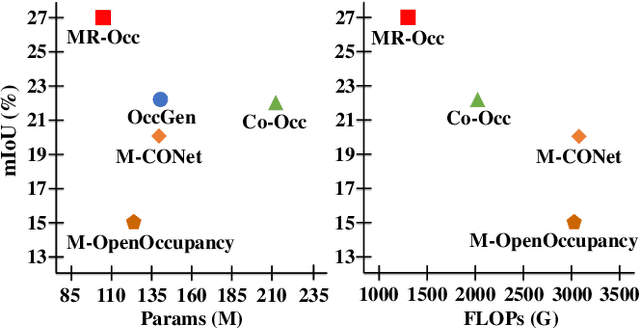
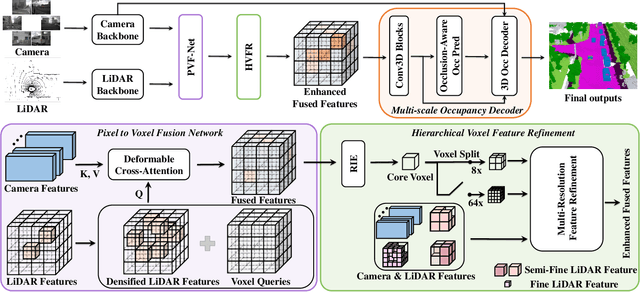
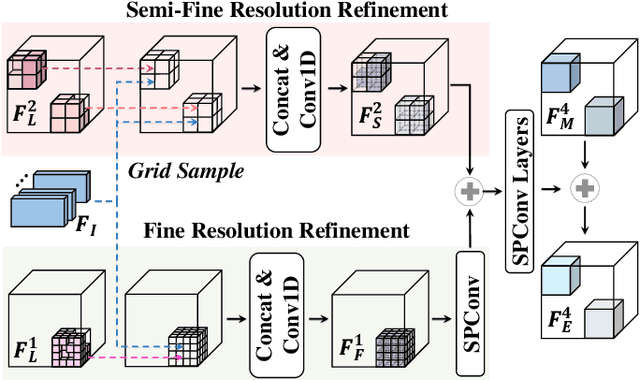
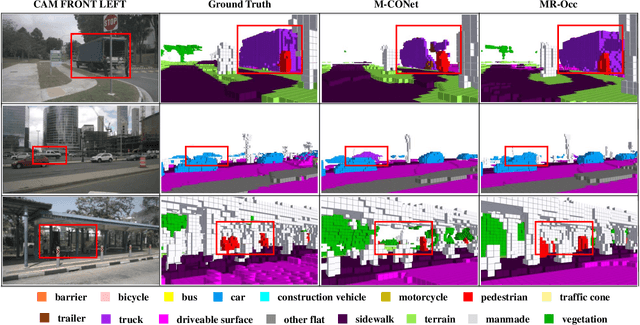
Abstract:Accurate 3D perception is essential for understanding the environment in autonomous driving. Recent advancements in 3D semantic occupancy prediction have leveraged camera-LiDAR fusion to improve robustness and accuracy. However, current methods allocate computational resources uniformly across all voxels, leading to inefficiency, and they also fail to adequately address occlusions, resulting in reduced accuracy in challenging scenarios. We propose MR-Occ, a novel approach for camera-LiDAR fusion-based 3D semantic occupancy prediction, addressing these challenges through three key components: Hierarchical Voxel Feature Refinement (HVFR), Multi-scale Occupancy Decoder (MOD), and Pixel to Voxel Fusion Network (PVF-Net). HVFR improves performance by enhancing features for critical voxels, reducing computational cost. MOD introduces an `occluded' class to better handle regions obscured from sensor view, improving accuracy. PVF-Net leverages densified LiDAR features to effectively fuse camera and LiDAR data through a deformable attention mechanism. Extensive experiments demonstrate that MR-Occ achieves state-of-the-art performance on the nuScenes-Occupancy dataset, surpassing previous approaches by +5.2% in IoU and +5.3% in mIoU while using fewer parameters and FLOPs. Moreover, MR-Occ demonstrates superior performance on the SemanticKITTI dataset, further validating its effectiveness and generalizability across diverse 3D semantic occupancy benchmarks.
CRT-Fusion: Camera, Radar, Temporal Fusion Using Motion Information for 3D Object Detection
Nov 05, 2024
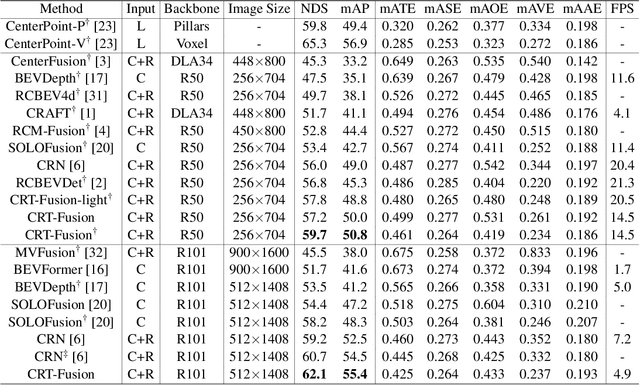
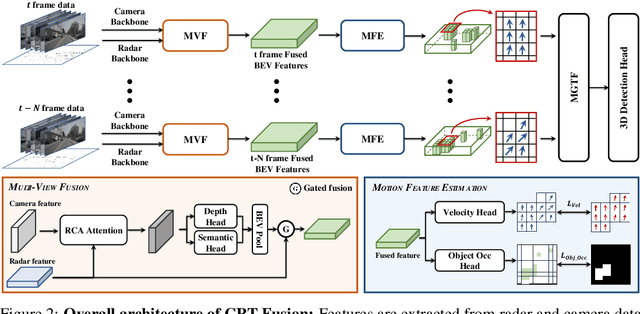
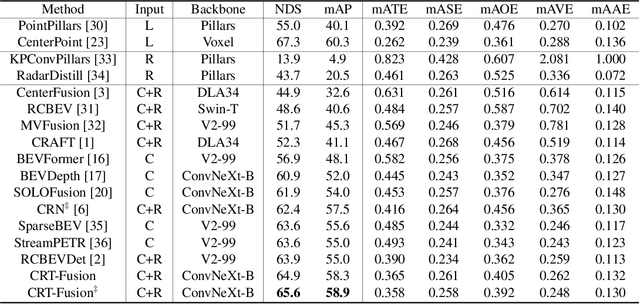
Abstract:Accurate and robust 3D object detection is a critical component in autonomous vehicles and robotics. While recent radar-camera fusion methods have made significant progress by fusing information in the bird's-eye view (BEV) representation, they often struggle to effectively capture the motion of dynamic objects, leading to limited performance in real-world scenarios. In this paper, we introduce CRT-Fusion, a novel framework that integrates temporal information into radar-camera fusion to address this challenge. Our approach comprises three key modules: Multi-View Fusion (MVF), Motion Feature Estimator (MFE), and Motion Guided Temporal Fusion (MGTF). The MVF module fuses radar and image features within both the camera view and bird's-eye view, thereby generating a more precise unified BEV representation. The MFE module conducts two simultaneous tasks: estimation of pixel-wise velocity information and BEV segmentation. Based on the velocity and the occupancy score map obtained from the MFE module, the MGTF module aligns and fuses feature maps across multiple timestamps in a recurrent manner. By considering the motion of dynamic objects, CRT-Fusion can produce robust BEV feature maps, thereby improving detection accuracy and robustness. Extensive evaluations on the challenging nuScenes dataset demonstrate that CRT-Fusion achieves state-of-the-art performance for radar-camera-based 3D object detection. Our approach outperforms the previous best method in terms of NDS by +1.7%, while also surpassing the leading approach in mAP by +1.4%. These significant improvements in both metrics showcase the effectiveness of our proposed fusion strategy in enhancing the reliability and accuracy of 3D object detection.
PillarGen: Enhancing Radar Point Cloud Density and Quality via Pillar-based Point Generation Network
Mar 08, 2024Abstract:In this paper, we present a novel point generation model, referred to as Pillar-based Point Generation Network (PillarGen), which facilitates the transformation of point clouds from one domain into another. PillarGen can produce synthetic point clouds with enhanced density and quality based on the provided input point clouds. The PillarGen model performs the following three steps: 1) pillar encoding, 2) Occupied Pillar Prediction (OPP), and 3) Pillar to Point Generation (PPG). The input point clouds are encoded using a pillar grid structure to generate pillar features. Then, OPP determines the active pillars used for point generation and predicts the center of points and the number of points to be generated for each active pillar. PPG generates the synthetic points for each active pillar based on the information provided by OPP. We evaluate the performance of PillarGen using our proprietary radar dataset, focusing on enhancing the density and quality of short-range radar data using the long-range radar data as supervision. Our experiments demonstrate that PillarGen outperforms traditional point upsampling methods in quantitative and qualitative measures. We also confirm that when PillarGen is incorporated into bird's eye view object detection, a significant improvement in detection accuracy is achieved.
RCM-Fusion: Radar-Camera Multi-Level Fusion for 3D Object Detection
Jul 27, 2023Abstract:While LiDAR sensors have been succesfully applied to 3D object detection, the affordability of radar and camera sensors has led to a growing interest in fusiong radars and cameras for 3D object detection. However, previous radar-camera fusion models have not been able to fully utilize radar information in that initial 3D proposals were generated based on the camera features only and the instance-level fusion is subsequently conducted. In this paper, we propose radar-camera multi-level fusion (RCM-Fusion), which fuses radar and camera modalities at both the feature-level and instance-level to fully utilize radar information. At the feature-level, we propose a Radar Guided BEV Encoder which utilizes radar Bird's-Eye-View (BEV) features to transform image features into precise BEV representations and then adaptively combines the radar and camera BEV features. At the instance-level, we propose a Radar Grid Point Refinement module that reduces localization error by considering the characteristics of the radar point clouds. The experiments conducted on the public nuScenes dataset demonstrate that our proposed RCM-Fusion offers 11.8% performance gain in nuScenes detection score (NDS) over the camera-only baseline model and achieves state-of-the-art performaces among radar-camera fusion methods in the nuScenes 3D object detection benchmark. Code will be made publicly available.
 Add to Chrome
Add to Chrome Add to Firefox
Add to Firefox Add to Edge
Add to Edge